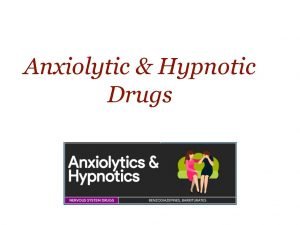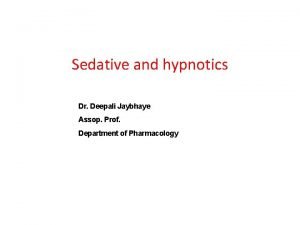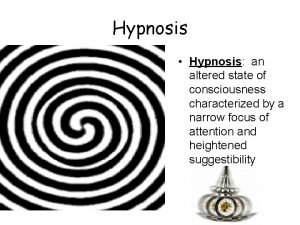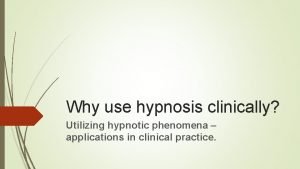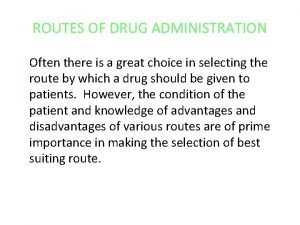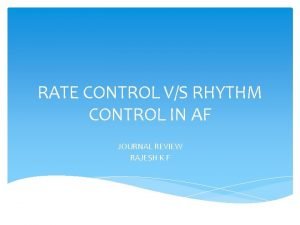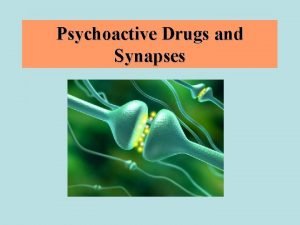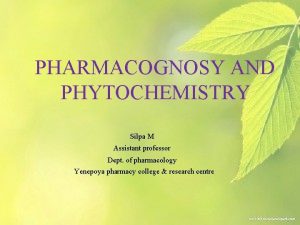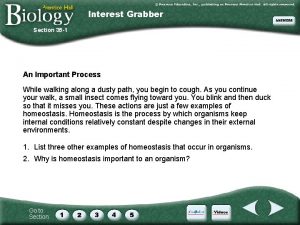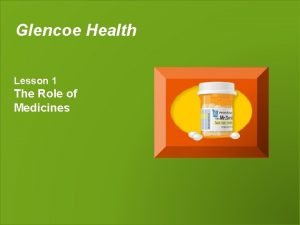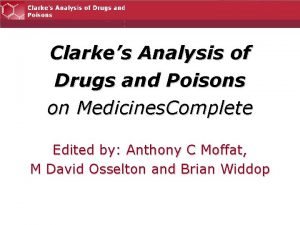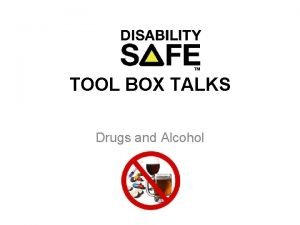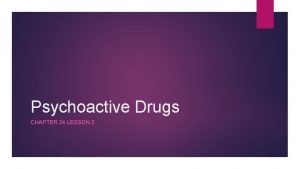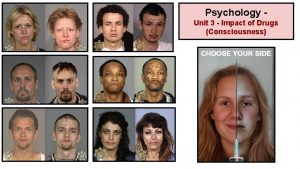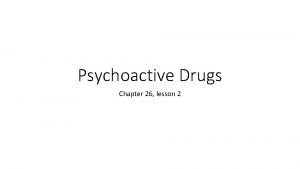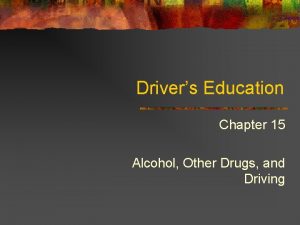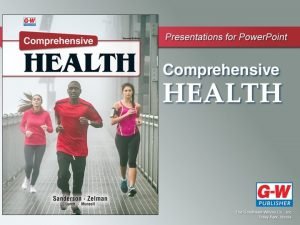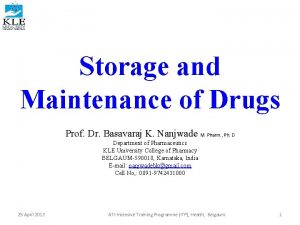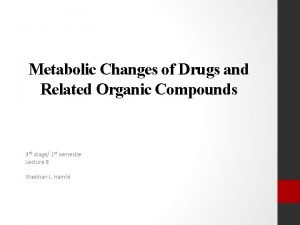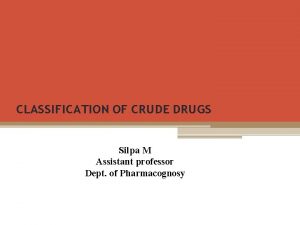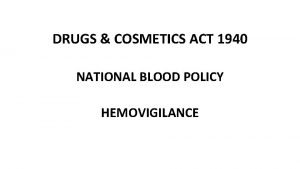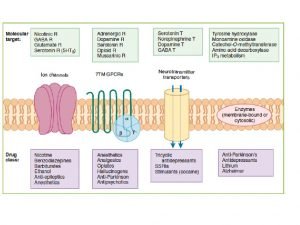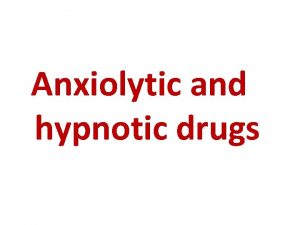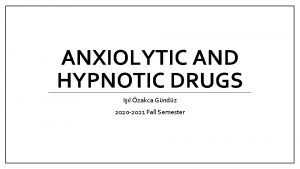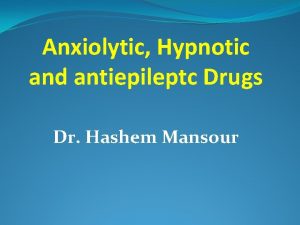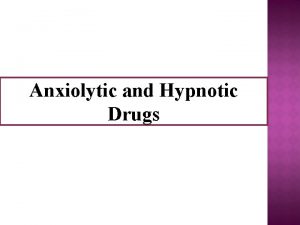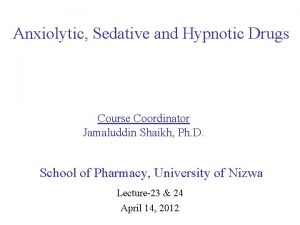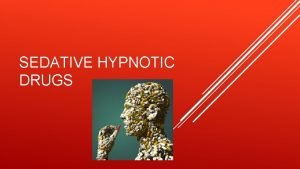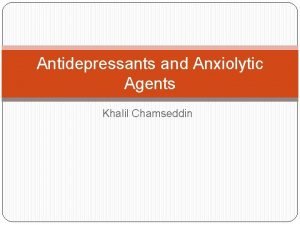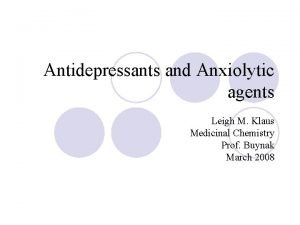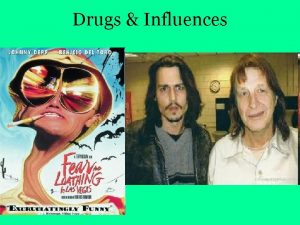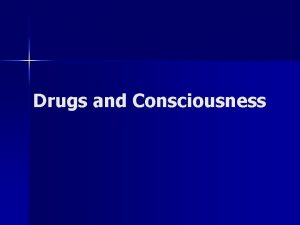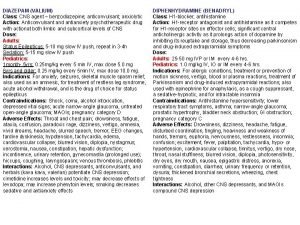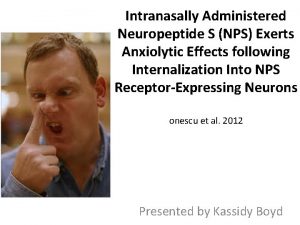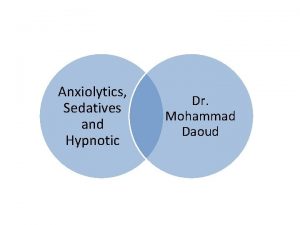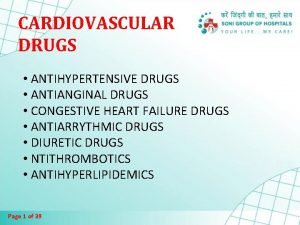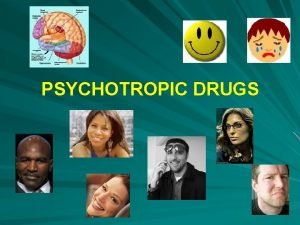Anxiolytic and Hypnotic drugs Anxiolytic and Hypnotic drugs































- Slides: 31

Anxiolytic and Hypnotic drugs

Anxiolytic and Hypnotic drugs • Anxiety is unpleasant state of tension and fear that seems to arise from unknown source. • The symptoms of severe anxiety are similar to those of fear (such as tachycardia, palpitation) and involve sympathetic activation. • Sever anxiety may be treated with antianxiety drugs and/or some form of behavioral and psychotherapy. • Because all of the antianxiety drugs also cause sedation, the same drugs often function clinically as both anxiolytic and hypnotic (sleep-inducing).

Benzodiazepines • Are the most widely used anxiolytic drugs. • have largely replaced barbiturates because they are safer and more effective.

COMPARISON OF THE DURATIONS OF ACTION OF THE BENZODIAZEPINES

• MOA: Benzodiazepines enhances the affinity of GABA receptors for gamm-aminobutyric acid (GABA) receptors. GABA is the major inhibitory neurotransmitter in the CNS. • Binding of GABA to its receptors triggers the opening of chloride channel, which leads to an increase in the chloride conductance. • The influx of chloride ions causes a small hyperpolarization that moves the postsynaptic potential away from its firing threshold and thus inhibits the formation of action potentials. • Benzodiazepines bind to GABA receptors resulting in a more frequent opening of adjacent chloride channels specific, high affinity sites on the cell membrane, which are separate from but adjacent to the receptor for GABA.


Benzodiazepines • They do not have analgesic action nor antipsychotic, but they exhibit the following actions: A. Reduction of anxiety (anxiolytic), at low doses. They are useful in treating the anxiety that accompanies some form of depression and schizophrenia. These agents should not be used to alleviate the normal stress of everyday life, and should be reserved to sever anxiety. Should be used for short periods of time because of the addiction potential.

• The longer acting benzodiazepines, such as Diazepam, are preferred with anxiety that may require treatment for prolonged periods of time. • The anti-anxiety effects of the Benzodiazepines is less subject to tolerance than the sedative and hypnotic effects. • Tolerance is decreased responsiveness to repeated doses of drug-occur when used for more than one to two weeks. cross tolerance exists among this group of agents and has been associated with a decrease in GABA receptors density.

B. Muscular relaxant: at high doses relax the spasticity of skeletal muscles probably by increasing presynaptic inhibition in the spinal cord. Diazepam is useful in the treating a muscle spasm such as occur in muscle strain, and in treating spasticity from degenerative disorder such as multiple sclerosis.

C. Sedative and hypnotic: all Benzodiazepines used to treat anxiety have some sedative properties and some can produce hypnosis. However, not all are useful as hypnotic agents. It is important to balance the sedative effect needed at bedtime with the residual sedation (hangover) on awakening. The three most commonly prescribed for sleep disorder are longacting Flurazepam, intermediate-acting Temazepam, and short -acting Triazolam. hypnotics should be given for only a limited time, usually less than 2 to 4 weeks.

CATEGORIES OF INSOMNIA Transient insomnia Short-term insomnia Long-term insomnia • Lasts <3 days • 3 days to 3 weeks • ---Caused by a brief environmental or situational stressor. • lasted for >3 weeks • --- Caused by a personal • ---No specific stressor may stressor such as illness, grief, be identifiable. or job problems. • ---A more complete medical • ---Respond to attention to • ---Sleep hygiene education evaluation is necessary in sleep hygiene rules. is the first step. these patients, but most do not need an all-night sleep • --- Hypnotics should be used • ---Hypnotics may be used study. at the lowest dose and for adjunctively for 7 -10 nights. only 2 -3 nights. • ---- Hypnotics are best used intermittently during this time, with the patient skipping a dose after 1 -2 nights of good sleep.

PK criteria Long-acting compounds (e. g. flurazepam) may ensure that a patient will sleep through the night, they also may cause cumulative effects resulting in daytime sluggishness or drug hangover Short-acting compounds (e. g. triazolam) avoid the hangover problem, but their use may be associated with early awakening and an increase in daytime anxiety 12

LONG-TERM INSOMNIA Nonpharmacological treatments are important for all patients with longterm insomnia. These include • Reduced caffeine intake • Avoidance of alcohol • Adequate exercise • Relaxation training • Behavioral-modification approaches, such as sleep-restriction and stimulus-control therapies. • Nonpharmacological treatments for insomnia have been found to be particularly effective in reducing sleep-onset latency and time awake after sleep onset.

D. Anticonvulsant: several Benzodiazepines have anticonvulsant activity and used to treat epilepsy and other seizure disorder. Clonazepam is useful chronic treatment of epilepsy, whereas diazepam is the drug of choice in terminating grand-mal epileptic seizers. E. Anterograde amnesia: Benzodiazepines does produce temporary impairment of memory. The short –acting agents are employed in premedication for endoscopic and bronchoscopic procedures such as angioplasty.

Benzodiazepines • Adverse effect: (1) Drowsiness and confusion: the two most common side effects. (2) Ataxia occurs at high doses and precludes activities that require fine motor coordination. (3) Cognitive impairment, can occur. (4) Triazolam often shows rapid development of tolerance, early morning insomnia, daytime anxiety. • Interaction and precautions: (1) Used cautiously in treating patient with liver diseases. (2) Should be avoid with acute narrow angle glaucoma. (3) Alcohol and other CNS depressant enhance the sedativehypnotic effect.

Benzodiazepines • Physiological and physical dependence can developed if high doses of the drug are given over a prolonged period. • Sudden withdrawal of benzodiazepines results in withdrawal symptoms, and tension. • Benzodiazepine withdrawal syndrome is benzodiazepines or during dosage reduction. caused by stopping • Because of the long half-lives of some of the Benzodiazepine withdrawal symptoms may not occur until a number of days after discontinuation of therapy • Withdrawal symptoms including confusion, anxiety, agitation, insomnia, and tension. • Over dose Flumazenil is the only benzodiazepine receptor antagonist available for clinical use. The drug is available by IV administration only. Onset is rapid but duration is short, with a half-life of about one hour.

New Benzodiazepine Receptor Agonists • An hypnotic agent that act on the same receptors as benzodiazepines. Nonetheless, it has no anticonvulsant effect nor muscle relaxation. • It shows minimal withdrawal effects and little or no tolerance effect occur with prolonged use. • Currently it is the most frequently prescribed hypnotic drug in the United States. • Although zolpidem potentially has advantages over the benzodiazepines, clinical experience with the drug is still limited. • Adverse effects includes nightmares, agitation, headache, daytime drowsiness.

ZALEPLON ZOLPIDEM • Its plasma t 1/2 is ~1 hours • Its plasma t 1/2 is ~2 hours • approved for use immediately at bedtime or when the patient has difficulty falling asleep after bedtime. • Cover most of a typical 8 -hour sleep period, and is presently approved for bedtime use only.

Novel Benzodiazepine Receptor Agonists • Zaleplon and zolpidem are effective in relieving sleep-onset insomnia. Both drugs have been approved by the FDA for use for up to 7 -10 days at a time. • Zaleplon and zolpidem have sustained hypnotic efficacy without occurrence of rebound insomnia on abrupt discontinuation.

MELATONIN CONGENERS RAMELTEON • Synthetic tricyclic analog of MELATONIN. • It was approved for the treatment of insomnia, specifically sleep onset difficulties. MECHANISM OF ACTION • Melatonin levels in the suprachiastmatic nucleus rise and fall in a circadian fashion concentrations increasing in the evening as an individual prepares for sleep, and then reaching a plateau and ultimately decreasing as the night progresses.

MELATONIN CONGENERS Mechanism of Action • Two GPCRs for melatonin, MT 1 and MT 2, are found in the suprachiasmatic nucleus, each playing a different role in sleep. • RAMELTEON binds to both MT 1 and MT 2 receptors with high affinity. • Binding of Melatonin to MT 1 receptors promotes the onset of sleep. • Binding of Melatonin to MT 2 receptors shifts the timing of the circadian system. • RAMELTEON is efficacious in combating both transient and chronic insomnia

Buspirone • Is useful in treatment of generalized anxiety disorders, and has efficacy comparable to benzodiazepines. • Its action is mainly mediated by serotonin (5 HT) receptors. • The anxiolytic effects of buspirone may take more than a week to become established, making the drug unsuitable for management of acute anxiety states (not very effective in panic disorders). • buspirone lacks anticonvulsant and muscle-relaxant properties of the benzodiazepines and causes only minimal sedation. • The frequency of adverse effects is low, the most common effects being headaches, dizziness, nervousness.

Barbiturates • The Barbiturates were formally the mainstay of the treatment used to sedate the patient or to induce and maintain sleep. • Today they have been largely replaced by the benzodiazepines because they induce tolerance, physical dependence and very severe withdrawal symptoms, and most importantly, their ability to cause coma in toxic doses. • Short acting barbiturates such as Thiopental is still used to induced anesthesia.


Barbiturates • • A. They exert their action by binding to GABA receptors and so potentiate the GABA action on the chloride channel opening (prolonging the opening duration). The binding site is distinct from that of benzodiazepines. In addition they can block excitatory glutamate receptors. Their action summarized in: Depression of the CNS: at low doses they produce sedation, and high doses they cause hypnosis. thus it is useful as anesthetic. The selection of barbiturate is strongly influenced by the desired duration of action. The ultra short barbiturate such as thiopental are used intravenously to induce anesthesia.


Barbiturates B. Anticonvulsant: Phenobarbital (long-acting) is used in longterm management of tonic-clonic seizures, status epilepticus. Phenobarbital has been regarded as the drug of choice for treatment of young children with febrile seizure. However, it can depress cognitive performance in children and the drug should be used cautiously. C. Anxiety: barbiturates have been used as mild sedative to relieve anxiety, nervous tension and insomnia. (replaced by benzodiazepines).

Adverse effects and interactions a. b. c. Respiratory depression: they suppress the hypoxic receptors that response to CO 2, and overdosage is followed by respiratory depression and death. for many decades, barbiturates poisoning has been a leading cause of death among drug overdose. Enzyme induction: they induce the CYP 450 microsomal enzymes in the liver, and thus interact with many drugs. CNS effects: cause drowsiness, impaired concentration. d. Drug hangover: hypnotic doses produce a feeling of tiredness after patient awake (many hours). e. Physical dependence: sudden withdrawal may cause tremors and anxiety and weakness

Features of withdrawal and dependence vary. Commonly there is a kind of psychological dependence based on the fact that the treatment works to reduce patients' anxiety or sleep disturbance and therefore they are unwilling to stop. If they do stop, there can be relapse, where original symptoms return. Withdrawal of BDZs should be gradual after as little as 3 weeks' use but for long-term users it should be very slow, e. g. about 6– 12 weeks. Withdrawal should be slowed if marked symptoms occur and it may be useful to substitute a long t 1/2 drug (e. g. diazepam) to minimize rapid fluctuations in plasma concentrations. In difficult cases withdrawal may be assisted by concomitant use of an antidepressant.

** ﻟﻠﺤﻔﻆ ﻣﺶ Dosages of drugs used commonly for sedation and hypnosis Sedation Drug Hypnosis Dosage Drug Dosage (at Bedtime) Alprazolam (Xanax) 0. 25 -0. 5 mg 2 -3 times daily Chloral hydrate 500 -1000 mg Buspirone (Bu. Spar) 5 -10 mg 2 -3 times daily Estazolam (Pro. Som) 0. 5 -2 mg Chlordiazepoxide (Librium) 10 -20 mg 2 -3 times daily Eszopiclone (Lunesta) 1 -3 mg Clorazepate (Tranxene) 5 -7. 5 mg twice daily Lorazepam (Ativan) 2 -4 mg Diazepam (Valium) 5 mg twice daily Quazepam (Doral) 7. 5 -15 mg Halazepam (Paxipam) 20 -40 mg 3 -4 times daily Secobarbital 100 -200 mg Lorazepam (Ativan) 1 -2 mg once or twice daily Temazepam (Restoril) 7. 5 -30 mg Oxazepam 15 -30 mg 3 -4 times daily Triazolam (Halcion) 0. 125 -0. 5 mg Phenobarbital 15 -30 mg 2 -3 times daily Zaleplon (Sonata) 5 -20 mg Zolpidem (Ambien) 5 -10 mg

Sedative/Hypnotics All of the anxiolytics/sedative/hypnotics should be used only for symptomatic relief. ******* All the drugs used alter the normal sleep cycle and should be administered only for days or weeks, never for months. ****** USE FOR SHORT-TERM TREATMENT ONLY!!
 Anxiolytic drugs
Anxiolytic drugs Hypnotic drugs
Hypnotic drugs Hypnosis is an altered state of consciousness
Hypnosis is an altered state of consciousness Hypnotic phenomena
Hypnotic phenomena When was remains by simon armitage written
When was remains by simon armitage written Topiocal
Topiocal Rate and rhythm control drugs
Rate and rhythm control drugs Neurotransmitters and drugs
Neurotransmitters and drugs Differentiate between organised and unorganised drug
Differentiate between organised and unorganised drug Section 35-5 drugs and the nervous system answer key
Section 35-5 drugs and the nervous system answer key Transesophageal echocardiogram procedure
Transesophageal echocardiogram procedure Chapter 19 lesson 1 the role of medicines
Chapter 19 lesson 1 the role of medicines Chapter 7 alcohol other drugs and driving
Chapter 7 alcohol other drugs and driving Clarke's analysis of drugs and poisons
Clarke's analysis of drugs and poisons Drugs and alcohol toolbox talk
Drugs and alcohol toolbox talk The not dead remains
The not dead remains Drugs that alter moods thoughts and sense perceptions
Drugs that alter moods thoughts and sense perceptions Unit 3 house and home
Unit 3 house and home Psychedelic drugs that distort perceptions and evoke
Psychedelic drugs that distort perceptions and evoke Drug that alters moods, thoughts, and sense perceptions
Drug that alters moods, thoughts, and sense perceptions What are the different routes of drug administration
What are the different routes of drug administration Chapter 15 alcohol other drugs and driving
Chapter 15 alcohol other drugs and driving Chemistry food and drugs
Chemistry food and drugs Chapter 44 antiinflammatory and antigout drugs
Chapter 44 antiinflammatory and antigout drugs Chapter 11 medications and drugs
Chapter 11 medications and drugs Storage and maintenance of drugs
Storage and maintenance of drugs Metabolic changes of drugs and related organic compounds
Metabolic changes of drugs and related organic compounds светр
светр Define crude drug with example
Define crude drug with example Chapter 15 alcohol other drugs and driving
Chapter 15 alcohol other drugs and driving Blood bank regulation under drugs and cosmetics act
Blood bank regulation under drugs and cosmetics act Driver toolbox talks
Driver toolbox talks
